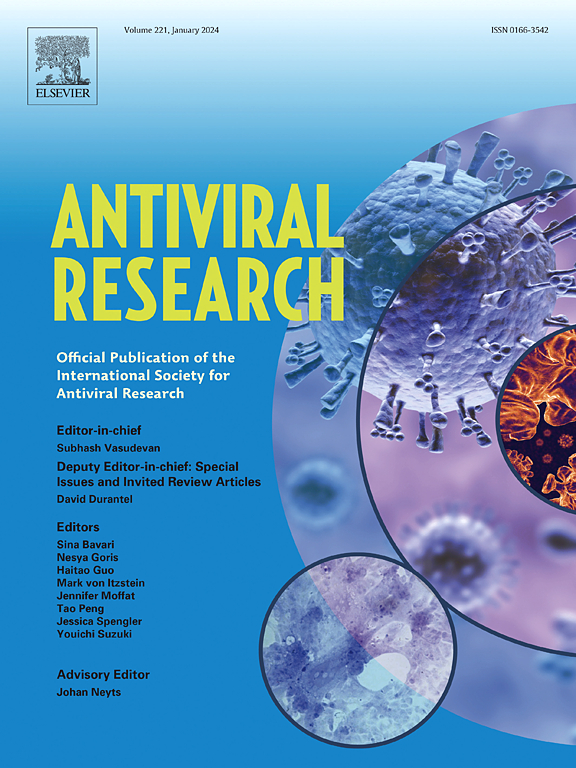Identifying hypaphorine as a novel antiviral compound against dengue virus
IF 4.5
2区 医学
Q1 PHARMACOLOGY & PHARMACY
引用次数: 0
Abstract
Approximately 390 million individuals globally are infected with dengue virus annually. Notably, no specific therapeutic strategy has been clinically approved for dengue fever to date. In this study, molecular docking screening against the methyltransferase (MTase) domain of the dengue virus (DENV) NS5 protein unveiled hypaphorine as a high-affinity ligand, with calculated binding energies of −6.657 kcal/mol (DENV2) and −6.663 kcal/mol (DENV3). This computational prediction was subsequently validated via cellular thermal shift assay (CETSA) and surface plasmon resonance imaging (SPRi), collectively demonstrating direct target engagement with a dissociation constant (KD) of 2.19 × 10−9 M. Functional characterization revealed that hypaphorine exhibited concentration-dependent inhibition of MTase enzymatic activity (IC50 = 29.9 μM). In antiviral assays, hypaphorine displayed dose-dependent suppression of viral replication in both BHK-21 (IC50 = 18.85 μM) and Huh-7 cells (IC50 = 15.7 μM), while maintaining low cytotoxicity (CC50 = 605.8 μM and 617.3 μM, respectively). Time-course analyses indicated maximal antiviral efficacy when hypaphorine was administered either pre- or post-infection (<24 hpi), which is consistent with the role of MTase in viral RNA capping during successive rounds of virus replication. The reduction in viral titer was found to correlate with MTase inhibition, thereby establishing a clear structure-activity relationship. These findings systematically characterize hypaphorine as a first-in-class natural MTase inhibitor, highlighting the utility of structure-guided approaches in anti-flaviviral drug discovery.
垂体后叶素作为一种新型登革热病毒抗病毒化合物的鉴定
全球每年约有3.9亿人感染登革热病毒。值得注意的是,迄今为止尚无临床批准的针对登革热的特定治疗策略。在本研究中,针对登革热病毒(DENV) NS5蛋白甲基转移酶(MTase)结构域的分子对接筛选揭示了hypaphorine是一个高亲和力配体,计算出的结合能为−6.657 kcal/mol (DENV2)和−6.663 kcal/mol (DENV3)。随后通过细胞热移测定(CETSA)和表面等离子体共振成像(SPRi)验证了这一计算预测,共同证明了直接作用于目标的解离常数(KD)为2.19 × 10−9 m。功能表征显示,hypaphorine对MTase酶活性的抑制呈浓度依赖性(IC50 = 29.9 μM)。在抗病毒实验中,hypaphorine对bkh -21细胞(IC50 = 18.85 μM)和Huh-7细胞(IC50 = 15.7 μM)均表现出剂量依赖性抑制病毒复制,同时保持低细胞毒性(CC50分别为605.8 μM和617.3 μM)。时间过程分析表明,在感染前或感染后(24 hpi)给予hypaphorine时,抗病毒效果最大,这与MTase在病毒复制的连续几轮病毒RNA封顶中的作用是一致的。发现病毒滴度的降低与MTase抑制相关,从而建立了明确的构效关系。这些发现系统地描述了hypaphorine作为一种一流的天然MTase抑制剂,突出了结构引导方法在抗黄病毒药物发现中的实用性。
本文章由计算机程序翻译,如有差异,请以英文原文为准。
求助全文
约1分钟内获得全文
求助全文
来源期刊

Antiviral research
医学-病毒学
CiteScore
17.10
自引率
3.90%
发文量
157
审稿时长
34 days
期刊介绍:
Antiviral Research is a journal that focuses on various aspects of controlling viral infections in both humans and animals. It is a platform for publishing research reports, short communications, review articles, and commentaries. The journal covers a wide range of topics including antiviral drugs, antibodies, and host-response modifiers. These topics encompass their synthesis, in vitro and in vivo testing, as well as mechanisms of action. Additionally, the journal also publishes studies on the development of new or improved vaccines against viral infections in humans. It delves into assessing the safety of drugs and vaccines, tracking the evolution of drug or vaccine-resistant viruses, and developing effective countermeasures. Another area of interest includes the identification and validation of new drug targets. The journal further explores laboratory animal models of viral diseases, investigates the pathogenesis of viral diseases, and examines the mechanisms by which viruses avoid host immune responses.
 求助内容:
求助内容: 应助结果提醒方式:
应助结果提醒方式:


